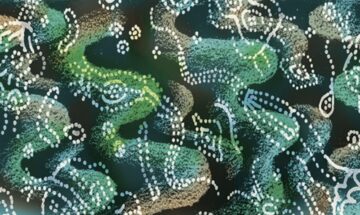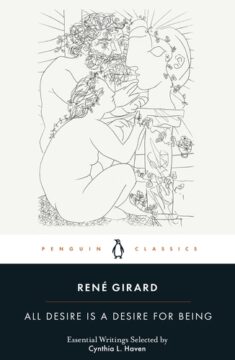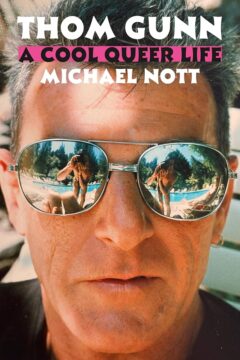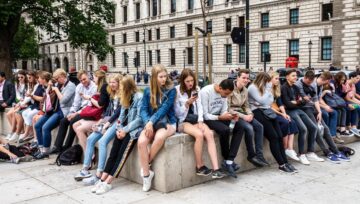Georgia Ray at Asterisk:
 Recently, a team at Stanford University fished something new out of the vast, uncharted, and almost entirely unclassified world of genetic material sometimes known as biological dark matter. They called it an “obelisk,” a shell-less RNA of maybe 1,000 base pairs (shorter than any viral genome), which seems to self-organize into a rodlike shape. It appears to be the structural equivalent of a plant viroid or a fungal ambivirus, two other bits of self-replicating genetic material whose discovery widened the boundaries of what we know about microbiology. But the obelisks weren’t found in either plants or fungi. They were discovered in human intestines.
Recently, a team at Stanford University fished something new out of the vast, uncharted, and almost entirely unclassified world of genetic material sometimes known as biological dark matter. They called it an “obelisk,” a shell-less RNA of maybe 1,000 base pairs (shorter than any viral genome), which seems to self-organize into a rodlike shape. It appears to be the structural equivalent of a plant viroid or a fungal ambivirus, two other bits of self-replicating genetic material whose discovery widened the boundaries of what we know about microbiology. But the obelisks weren’t found in either plants or fungi. They were discovered in human intestines.
An obelisk, in other words, is a probably replicating entity, contained in a mere thousand or so letters of the genetic alphabet, with zero genetic similarity to anything known to exist already. What does it do? How did it get there? Does it cause disease? We have no idea. We first picked up the phone this year (the preprint announcing its discovery was published in January 20241 ). It is a complete stranger calling from inside the house.
More here.
Enjoying the content on 3QD? Help keep us going by donating now.

 Interest in
Interest in  O
O I grew up on the north side of Chicago in a pretty diverse school district that had students with backgrounds hailing from all corners of the world. I remember hearing a classmate speak to his mom in Polish when she picked him up. Another classmate brought Pakistani Biryani his mom made for lunch. It was a quite riveting experience at a young age to have exposure to such a vibrant student body. Everyone had a story, a history, a culture, yet we were all American kids raised on a steady diet of pop culture and pop tarts. Nonetheless, these kids’ subtle yet unique cultural undertones first sparked my curiosity to know more about the world.
I grew up on the north side of Chicago in a pretty diverse school district that had students with backgrounds hailing from all corners of the world. I remember hearing a classmate speak to his mom in Polish when she picked him up. Another classmate brought Pakistani Biryani his mom made for lunch. It was a quite riveting experience at a young age to have exposure to such a vibrant student body. Everyone had a story, a history, a culture, yet we were all American kids raised on a steady diet of pop culture and pop tarts. Nonetheless, these kids’ subtle yet unique cultural undertones first sparked my curiosity to know more about the world. An artificial-intelligence tool honoured by this year’s Nobel prize
An artificial-intelligence tool honoured by this year’s Nobel prize In ‘Dreams Must Explain Themselves’ (1973), Le Guin touches on the reference works that she consults for her writing (I’m a
In ‘Dreams Must Explain Themselves’ (1973), Le Guin touches on the reference works that she consults for her writing (I’m a 
 I
I  But if there was little obvious distinction between “religious” pilgrims and “regular” travelers, it was partly because the discourse of contemporary travel is so often geared toward the same ends as pilgrimage proper: a journey that results in the transformation, and ideally purification, of the searching self. This is the goal underlying, for example, travel-as-transformation narratives like Cheryl Strayed’s Wild, an account of the author’s solo hike along the Pacific Crest Trail, and Elizabeth Gilbert’s divorce-and-self-actualization memoir Eat, Pray, Love. Travel, at least the kind of travel so often coded as “real” or “authentic” (as opposed to, say, the family resort vacation, the Instagram trip, or the perfunctory list-ticking of the much-derided “tourist”), is already treated as a kind of secular pilgrimage in which we find out who we really are only by untethering ourselves from those elements of our identities too closely linked to habit and home. Only when we are away from our daily routines, this ideology implies, from our bosses and spouses and children, when we are challenged by language barrier or public transit mishap or unexpected romantic chemistry, can we come to know who we really are.
But if there was little obvious distinction between “religious” pilgrims and “regular” travelers, it was partly because the discourse of contemporary travel is so often geared toward the same ends as pilgrimage proper: a journey that results in the transformation, and ideally purification, of the searching self. This is the goal underlying, for example, travel-as-transformation narratives like Cheryl Strayed’s Wild, an account of the author’s solo hike along the Pacific Crest Trail, and Elizabeth Gilbert’s divorce-and-self-actualization memoir Eat, Pray, Love. Travel, at least the kind of travel so often coded as “real” or “authentic” (as opposed to, say, the family resort vacation, the Instagram trip, or the perfunctory list-ticking of the much-derided “tourist”), is already treated as a kind of secular pilgrimage in which we find out who we really are only by untethering ourselves from those elements of our identities too closely linked to habit and home. Only when we are away from our daily routines, this ideology implies, from our bosses and spouses and children, when we are challenged by language barrier or public transit mishap or unexpected romantic chemistry, can we come to know who we really are. T
T Human life expectancy dramatically increased last century. Compared to babies born in 1900, those born at the turn of the 21st century could live, on average, three decades longer—
Human life expectancy dramatically increased last century. Compared to babies born in 1900, those born at the turn of the 21st century could live, on average, three decades longer— It is midday on a Friday, and I am in a room with about a dozen teenagers at an international school in Oslo, Norway. We are talking about how and why they use TikTok, the digital video-sharing application. The prevailing mood is laid-back: though I am technically a media researcher, and they are technically my research participants, this group of 16- and 17-year-olds are joking around with each other and with me as we chat about the role of TikTok in their everyday lives. It’s a beautiful day – warm and summery – and everyone, including me, is in a fun weekend mood.
It is midday on a Friday, and I am in a room with about a dozen teenagers at an international school in Oslo, Norway. We are talking about how and why they use TikTok, the digital video-sharing application. The prevailing mood is laid-back: though I am technically a media researcher, and they are technically my research participants, this group of 16- and 17-year-olds are joking around with each other and with me as we chat about the role of TikTok in their everyday lives. It’s a beautiful day – warm and summery – and everyone, including me, is in a fun weekend mood.